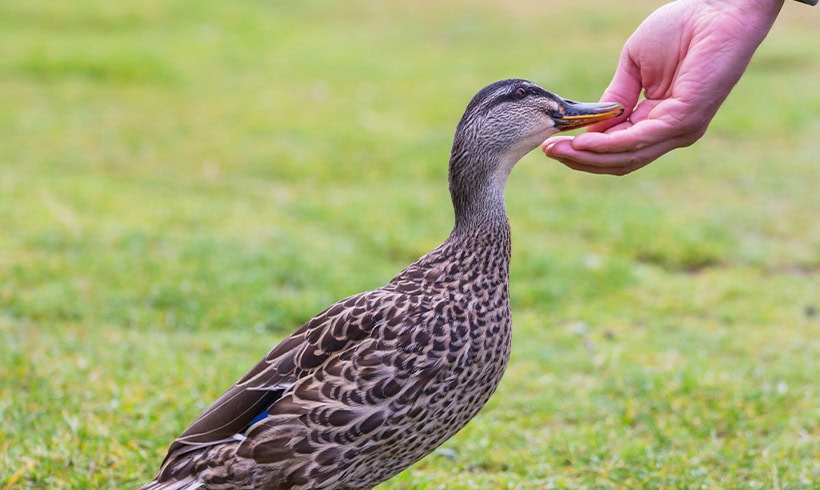Please don’t feed the ducks
Tossing a few crackers or scraps of bread to a passing duck may seem like a harmless pastime but feeding wildlife has a range of consequences for our feathered friends. Help us keep the wildlife who use Teatown’s waterways happy and healthy by keeping our food out of reach.

Nutrition
While foods like bread, popcorn, crackers, and bleached grains may technically be edible for some waterfowl, they lack critical nutrients like protein and calcium. Filling up on empty calories from water-logged bread causes the birds to become malnourished and can lead to symptoms of metabolic bone disease like malformed wings and fragile eggs. Wild ducks need a balanced diet of grasses, aquatic plants, and invertebrates to survive and reproduce successfully. Even nutrient-dense foods like commercial bird feed are problematic; young birds can grow too quickly resulting in abnormal flight feathers that twist out at odd angles. Once an animal is weak, it is more likely to seek out human food sources, causing a vicious cycle that incites further harm.
Habituation
When wild animals associate humans with food, whether by purposeful feedings or accidental offerings (i.e., picnic scraps left in the grass), they become a danger to both themselves and humans. Swans and geese have been known to act aggressively toward people in popular feeding spots like parks which often leads to their permanent (and typically lethal) removal. A duck may pack less of a punch, but will become more susceptible to predation, vehicle collision, and potential injury from plastic entanglement when lured closer to human activity with the promise of a meal.
Disease
Two issues arise as wildlife congregates around a plentiful food source. Initially, the population’s carrying capacity is artificially inflated due to the abundance of food. Some ducks may have additional offspring while other individuals gather in unusually high numbers. The subsequent overcrowding allows fungal infections, bacterial disease, and avian viruses to spread rapidly throughout the group, decimating the population. Overcrowding can also trigger increased aggression as individuals fight for limited food, shelter, and reproductive partners.
Habitat Degradation and Water Quality
Finally, the impacts of feeding ducks are felt by the entire ecosystem. More ducks mean more duck droppings and therefore increased water pollution. The excess nutrients promote algal growth which can be dangerous to both wildlife and humans who drink from or recreate in the waterbody.
You can still enjoy the ducks
One cracker won’t upset the entire ecosystem, but one cracker from everyone who wants to give a cracker, will. You can still enjoy birdwatching with your family without wreaking havoc on the environment by grabbing a pair of binoculars or waiting calmly by the water. Practice “Leave No Trace” principles and be sure to carry out whatever you carry in. Next time you head outside just remember: please don’t feed the ducks.

About the Author
Nadya Hall
Community Environmentalist
Nadya has her master’s in environmental policy with a focus on human-wildlife coexistence. She is passionate about the conservation of wildlife and wild places through science, advocacy, and environmental education.


Leave a Reply